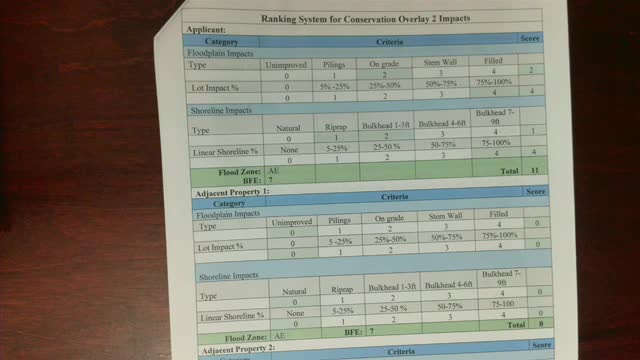Flood Mitigation Strategies Spark Heated Debate Among Officials
July 02, 2024 | St. Augustine, St. Johns County , Florida

This article was created by AI summarizing key points discussed. AI makes mistakes, so for full details and context, please refer to the video of the full meeting. Please report any errors so we can fix them. Report an error »

In a recent government meeting, officials discussed critical flood mitigation strategies and the implications of proposed developments on neighboring properties. The dialogue centered around a new ranking system designed to assess the impact of flood mitigation projects on adjacent properties, allowing for incremental improvements along shorelines rather than sweeping changes that may not be feasible.
One key point raised was the importance of comparing the proposed flood mitigation strategies with the existing conditions of neighboring properties. The ranking system assigns scores from 0 to 16, with higher scores indicating greater potential impact on neighbors. This approach aims to ensure that new developments do not exacerbate flooding issues for nearby residents.
The meeting also addressed a specific application for a boat lift installation that had been constructed without the necessary permits. Staff recommended denial of the application due to inconsistencies with existing regulations. The applicant argued for a variance, citing the need for a higher lift to protect expensive equipment from storm damage. However, board members expressed concerns about the lift's compliance with low-profile requirements, which are designed to minimize visual and environmental impacts.
The discussion highlighted the challenges of balancing development needs with environmental protection and community concerns. Board members emphasized the necessity of adhering to established codes and the importance of obtaining accurate measurements to ensure compliance. Ultimately, the board decided to continue the discussion on the boat lift application, allowing the applicant time to gather the required information and potentially revise the proposal to meet regulatory standards.
This meeting underscores the ongoing efforts of local government to navigate complex issues related to flood management and development while considering the interests of the community and the environment.
One key point raised was the importance of comparing the proposed flood mitigation strategies with the existing conditions of neighboring properties. The ranking system assigns scores from 0 to 16, with higher scores indicating greater potential impact on neighbors. This approach aims to ensure that new developments do not exacerbate flooding issues for nearby residents.
The meeting also addressed a specific application for a boat lift installation that had been constructed without the necessary permits. Staff recommended denial of the application due to inconsistencies with existing regulations. The applicant argued for a variance, citing the need for a higher lift to protect expensive equipment from storm damage. However, board members expressed concerns about the lift's compliance with low-profile requirements, which are designed to minimize visual and environmental impacts.
The discussion highlighted the challenges of balancing development needs with environmental protection and community concerns. Board members emphasized the necessity of adhering to established codes and the importance of obtaining accurate measurements to ensure compliance. Ultimately, the board decided to continue the discussion on the boat lift application, allowing the applicant time to gather the required information and potentially revise the proposal to meet regulatory standards.
This meeting underscores the ongoing efforts of local government to navigate complex issues related to flood management and development while considering the interests of the community and the environment.
View full meeting
This article is based on a recent meeting—watch the full video and explore the complete transcript for deeper insights into the discussion.
View full meeting